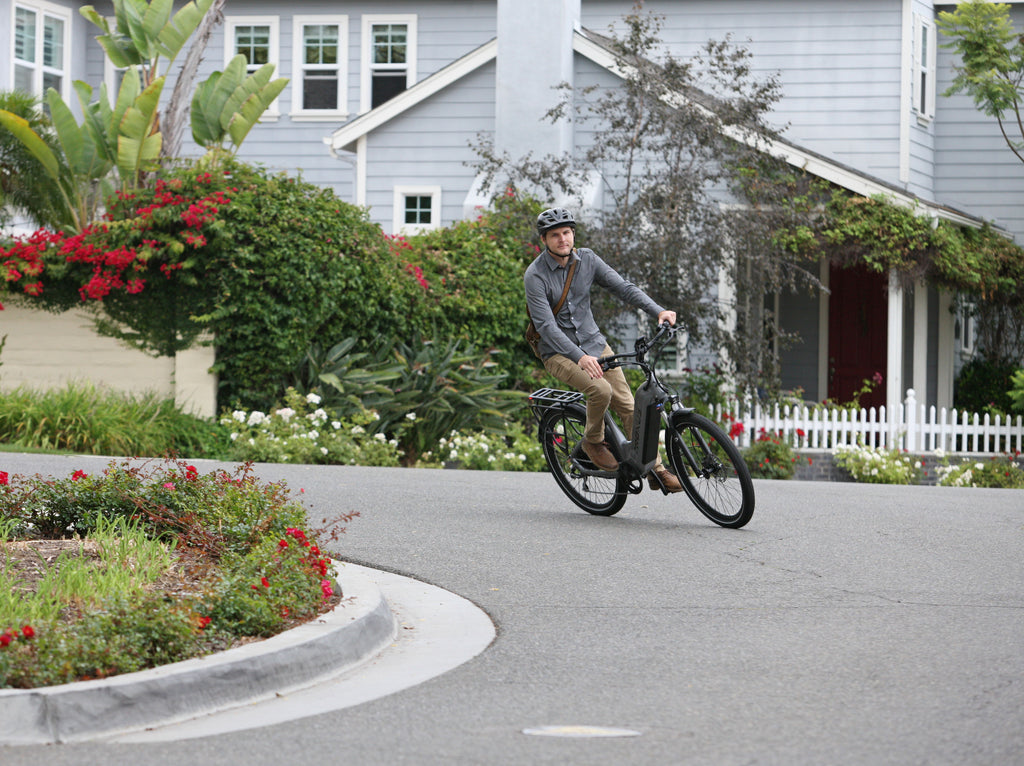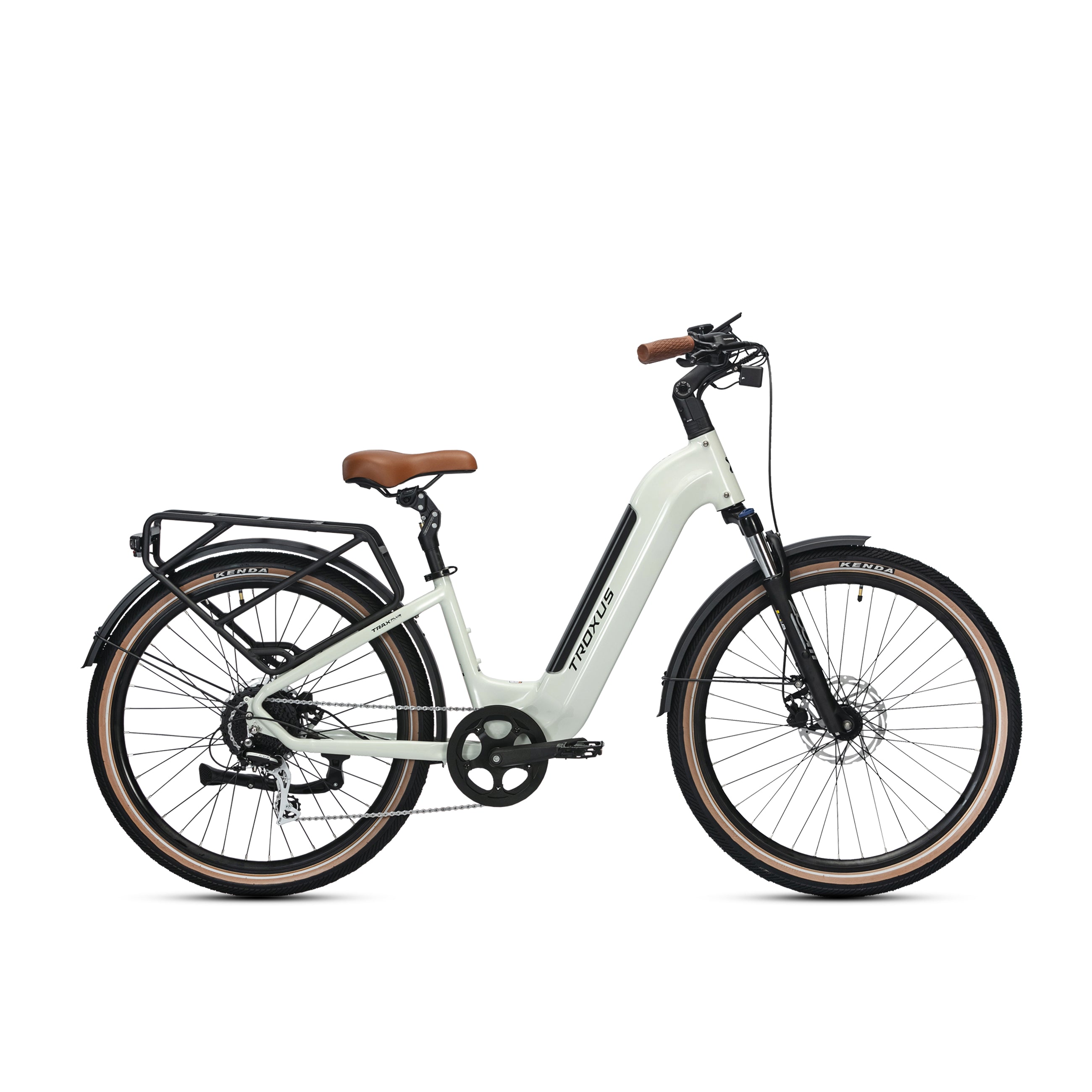Discover the allure of bicycles - from urban streets to rural landscapes. The iconic bicycle embodies freedom, adventure, and eco-friendly transportation. Enter the electric bike, revolutionizing cycling with its rising popularity. Are you torn between electric bikes and traditional bikes? Dive into our comprehensive comparison guide to make an informed choice tailored to your lifestyle, health, and environmental values.
Explore the features, benefits, and drawbacks of both options. Join us on a journey through the future of electric bikes and the timeless charm of traditional cycling. Whether you're a daily commuter, an outdoor enthusiast, or a leisure rider, let this guide be your trusted companion on your cycling adventure.
Content
The Advantages of Electric Bikes
The Drawbacks of Electric Bikes
Traditional Bicycles: The Age-Old Favorite
The Rise of Electric Bikes
Electric bikes, often celebrated for their assisted pedaling features, have swept the cycling world with their promise of easy travel and extended expeditions. Propelled forward by a small motor, these new-age contraptions are more than just a passing fad; they’re the harbinger of a cycling renaissance, championed by urban professionals and outdoor enthusiasts alike.
What Exactly Are Electric Bikes and How Do They Work?
Electric bikes, commonly referred to as electric bikes, are bicycles equipped with integrated electric motors to assist riders in propulsion. These innovative bikes offer diverse features - for instance, certain models operate on 'pedal-assist' mode, where the motor amplifies your pedaling effort, correlating with the intensity of your pedaling. On the other hand, some electric bikes enable a more relaxed ride by providing a throttle on the handlebar, allowing riders to enjoy a smooth journey as the motor takes on the brunt of the workload.
The Different Types of Electric Bikes
Electric bikes have become a versatile solution for riders, with a wide range of specialized options to cater to diverse riding preferences and needs. When choosing an electric bike, you can explore various models tailored to different purposes. For instance, you might consider the rugged mountain electric bike, featuring custom frames and tires for off-road adventures, or the sleek city electric bike designed for effortless urban commuting. Troxus E-bikes stands out in the diverse electric bike market with a wide selection of electric bicycles to meet global riders' various needs. Troxus excels in innovation, offering pedal-assist and throttle-controlled systems in their lineup. Whether you're commuting in the city or exploring off-road trails, Troxus has an electric bike for you.
Continue reading: Exploring the World of Electric Bikes: Pedaling Into the Future
Pedal-Assist Electric Bikes (Pedelecs):
Among electric bikes, pedal-assist models distinguish themselves as the leading and most preferred option in the market thanks to their user-friendly design. These cutting-edge bicycles operate by cleverly enhancing your pedaling actions using a motor that kicks in once sensors recognize pedaling motion and rider input. Featuring a range of customizable power modes, cyclists can effortlessly adapt to various terrains and personal riding styles, ensuring a smooth and optimized cycling journey on every outing. The seamless integration of technology and human effort not only enhances the overall biking experience but also promotes eco-friendly transportation alternatives for a sustainable future.
Throttle-Controlled Electric Bikes:
In contrast to pedal-assist electric bikes, throttle-controlled electric bikes function more like scooters, removing the necessity to pedal continuously. By activating the throttle, riders can let the motor take over for propulsion. These types of electric bikes often come with different speed settings, providing riders with more control over their riding experience. While less widespread than pedelecs, throttle-controlled electric bikes offer a convenient mode of transportation, particularly suitable for individuals with challenges in consistent pedaling, such as seniors or those with physical limitations. Riders can enjoy a smoother and more effortless ride, making it an appealing option for urban commuting or leisurely rides around town.
The Advantages of Electric Bikes
Electric bikes have transformed personal mobility, offering eco-friendly transportation, health benefits, cost-effectiveness, and pure joy in riding. These bikes revolutionize commutes and outdoor exploration.
Conquering the Tough Terrain and Commuting Hustle
Electric bikes revolutionize the cycling experience by leveling the playing field for riders, empowering them to effortlessly conquer steep hills with minimal exertion. Unlike traditional bikes that can prove to be a taxing workout on rugged terrain, electric bikes offer tailored assistance, ensuring your rides are not only more manageable but also incredibly enjoyable. Moreover, for urban commuters navigating bustling city centers, electric bikes eliminate the need to break a sweat and provide a quicker, more leisurely journey through congested traffic conditions.
With electric bikes, riders find a harmonious balance between exercise and ease, making cycling a delightful experience for beginners and seasoned cyclists alike. The electric assistance seamlessly integrates with your pedaling, offering a smooth ride that adapts to your desired level of effort. Whether you're a fitness enthusiast looking to explore challenging routes or a city dweller seeking a convenient and eco-friendly mode of transportation, electric bikes cater to a wide range of preferences and needs. Their versatility extends to various terrains, weather conditions, and commuting scenarios, making them a versatile choice for modern-day cyclists.
The Rider's Range and Endurance
One of the most practical benefits of electric bikes is the extended range they offer. With the assistance of an electric motor, electric bikes allow riders to cover greater distances on a single charge compared to traditional bicycles. This increased range is a game-changer for cyclists who enjoy touring or rely on their bikes for longer commutes. Additionally, electric bikes not only enhance the riding experience by minimizing fatigue but also enable riders to appreciate the surrounding scenery or cityscape without feeling exhausted. The convenience of electric bikes is especially advantageous for those who want to explore hilly terrains or tackle challenging routes with ease. Riders can now venture further, discover new paths, and enjoy longer rides without worrying about running out of power. This freedom to roam and the added boost provided by electric bikes open up a world of possibilities for cyclists, making every journey more exciting and accessible.
The Drawbacks of Electric Bikes
Explore the pros and cons of electric bikes: While they offer many benefits, potential buyers should consider drawbacks such as limited range, reliance on charging infrastructure, and higher initial cost.
The Initial Financial Shock
When looking at the comparison between traditional bicycles and electric bikes, it becomes apparent that the latter often carries a slightly higher price tag. This is primarily attributed to the incorporation of advanced technology and high-quality components that enhance the overall performance and efficiency of electric bikes. While the initial cost may raise concerns for some prospective buyers, diving deeper reveals the multitude of long-term advantages these bikes bring to the table. Not only do they promise significant savings on transportation expenses, but they also provide an elevated riding experience that traditional bikes may not match. As time progresses, the upfront investment in an electric bike is expected to pay off through the added convenience, improved efficiency, and sheer enjoyment they offer for daily commuting and leisurely rides.
Battery and Maintenance Challenges
E-bike batteries can indeed be bulky and contribute to the overall weight of the bike. While many batteries offer a reasonable lifespan, they do introduce an extra element that demands regular maintenance. The integration of the electric motor, sensors, and battery system increases the intricacy of the bike, potentially leading to higher repair expenses compared to traditional bicycles. This added complexity requires a more detailed understanding of maintenance procedures and potential issues that may arise over time.
When considering e-bike batteries, it's important to note that their weight distribution can affect the handling of the bike, especially during rides on varying terrains. Additionally, the charging process and storage of these batteries play a significant role in optimizing their performance and longevity. Riders should also be mindful of the environmental impact of battery disposal and explore sustainable options for battery recycling or disposal.
Traditional Bikes: The Age-Old Favorite
Traditional bicycles hold a special place in the cycling community alongside the buzz of electric revs. With their dependable, cost-effective, and straightforward design, they provide a reliable riding experience that resonates with many cyclists.
A Beacon of Health and Fitness
The health benefits of traditional cycling are extensively documented. Engaging in a ride on a conventional bicycle not only contributes to improved cardiovascular health, muscle development, and calorie burning, but it also plays a significant role in enhancing overall well-being. The rhythmic motion of pedaling has the remarkable ability to reduce stress levels and enhance mental clarity, offering a comprehensive workout experience that benefits both the body and mind. Moreover, the simplicity of traditional bikes fosters a profound connection with the surrounding environment, enabling riders to immerse themselves fully in appreciating the sights, sounds, and scents of nature as they traverse picturesque routes, creating a truly enriching cycling experience.
The Eco-Friendly Ride
Regular bikes, also known as traditional bicycles, stand out as the epitome of eco-friendly travel. These sustainable transportation options function without emitting any harmful gases, underscoring their strong environmental ethos. By steering clear of non-renewable energy sources and embracing human-powered propulsion, they emerge as the preferred mode of transit for environmental advocates keen on shrinking their carbon footprint. Each mile pedaled not only propels cyclists ahead but also contributes significantly to nurturing a cleaner, healthier environment, guiding us collectively towards a brighter, greener, and more sustainable future. The seamless integration of pedal power into daily commutes fosters a deeper sense of connection with the surroundings, promoting mindfulness and well-being.
A Critical Comparison
Compare electric bikes vs. traditional bicycles: cost, environmental impact, maintenance, & riding experience. Make an informed choice that fits your needs & preferences.
Assistance and Speed
- Electric Bikes (E-Bikes) offer electric assistance through a motor integrated into the bike. This assistance helps riders maintain higher speeds with less effort, conquer hills with ease, and extend their range to cover longer distances. Electric bikes are becoming increasingly popular for their ability to provide a smoother and more enjoyable cycling experience.
- Traditional bikes operate solely based on the rider's physical effort, demanding increased exertion when tackling uphill terrains, which can lead to a more challenging but rewarding riding experience. As a result, despite potentially lower average speeds, the sense of accomplishment and connection with the environment is heightened.
Fitness Benefits
- Electric Bikes: Offering a level of assistance that effectively reduces the physical strain can make fitness activities accessible to individuals with varying fitness levels and physical conditions. This inclusive approach ensures that a wider range of people can engage in physical activities comfortably and safely.
- Traditional Bikes: Requiring more effort than other workout methods, traditional exercises offer a classic approach that could potentially result in a more strenuous workout. This can be advantageous for enhancing both cardiovascular health and muscle strength, making it a well-rounded choice for overall fitness improvement.
Range and Endurance
- Electric Bikes: Enable cyclists to effortlessly traverse greater distances, thereby boosting their endurance levels and expanding the possibilities for extended rides. By reducing the effort required, riders can explore new routes, pushing their limits and enjoying the journey further.
- Traditional Bikes: Requiring more energy from the rider can put additional strain on their muscles and cardiovascular system, potentially limiting the distance they can cover. This increased demand for energy may result in quicker fatigue, especially during longer rides where sustained effort is needed.
Terrain Handling
- Electric Bikes: Exhibit exceptional proficiency in navigating demanding terrains, such as steep hills or rugged surfaces, thanks to the invaluable support offered by the electric motor system. This advanced technology enhances control and stability, making off-road adventures more enjoyable and accessible.
- Traditional Bikes: Requiring more physical effort, riders might encounter steeper hills or rugged, uneven terrain during their cycling adventures. These challenging landscapes not only test their stamina but also demand heightened concentration and endurance, amplifying the thrill and sense of accomplishment throughout the ride.
Commuting and Transportation
- Electric Bikes: Can be a more efficient and faster option for commuting, especially in busy urban areas characterized by heavy traffic congestion. They offer a practical alternative for individuals who require a convenient way to reach their destination promptly and without the inconvenience of arriving overly sweaty.
Continue reading: How to Choose the Perfect Commuter Electric Bike?

- Traditional Bikes: Still considered a viable option, bicycles offer not only an environmentally friendly mode of transportation but also a great way to stay active and enjoy the surroundings. However, for longer commutes or areas with steep inclines, they may prove to be less time-efficient compared to other modes of transport.
Cost
- Electric Bikes: Typically, electric vehicles have a higher upfront cost compared to traditional vehicles. This is mainly due to the inclusion of advanced electric components, high-capacity batteries, and sophisticated electric motors that contribute to their increased initial price point.
- Traditional Bikes: Generally, products that are more affordable upfront often come with the benefit of lower maintenance costs in the long run. This cost-effective approach can make them a wise choice for budget-conscious consumers looking to save money over time.
Maintenance
- Electric Bikes: Maintenance is crucial for ensuring the optimal performance and longevity of both traditional bike components, such as gears and brakes, as well as electric components like the motor and battery. Regular maintenance checks help uphold safety standards and the overall efficiency of your bike, whether you're cruising on a traditional bike or enjoying the perks of an electric one.
- Traditional Bikes: Generally, electric bikes have lower maintenance needs compared to traditional bicycles. With routine check-ups on standard bike components such as brakes, gears, and tires, you can ensure the smooth operation and longevity of your electric bike.
Environmental Impact
- Electric Bikes: Have a lower carbon footprint than some motorized transportation options as they run on electricity, which is a cleaner energy source. However, they still require electricity for charging, contributing to a more sustainable way of commuting.
- Traditional Bikes: Zero emissions, offering an environmentally friendly mode of transportation, help reduce air pollution and contribute to a cleaner, greener planet for future generations.
According to the study titled "E-bikes and their Potential to Reduce Car CO2 Emissions," in rural regions, a larger portion of trips can be undertaken using electric bikes that would not be feasible with conventional cycling. The data reveals that electric bikes offer a carbon reduction capability 125% greater than traditional bicycles in rural villages, but only 56% higher in major urban areas. When comparing electric bikes to bicycles, rural areas exhibit the most significant net carbon reduction capability.

Image source: ‘E-bikes and their capability to reduce car CO2 emissions’
Weight
- Electric Bikes: Typically, electric bikes tend to be heavier compared to traditional bicycles. This is primarily because of the added weight of the motor and battery components that are necessary for the electric bike's functionality.
- Traditional Bikes: Typically, vehicles that are lighter in weight tend to provide enhanced agility in handling. This agility not only allows for easier maneuvering around corners but also enhances the overall responsiveness on the road, making the driving experience smoother and more enjoyable.
Usage Scenarios
- Electric Bikes: Ideal for commuting in urban areas, casual riders exploring city streets, individuals with physical limitations seeking accessible transportation options, and outdoor enthusiasts who desire support while conquering rough terrains.
- Traditional Bikes: Ideal for fitness enthusiasts seeking an invigorating physical challenge, purists who relish the authentic biking experience, and riders who appreciate the simplicity and nostalgia of traditional biking.
Which Bike Is Right for You?
Choosing the perfect bike depends on various personal factors and your cycling goals. Find the best bike for you based on your preferences and cycling objectives.
Personal Fitness Goals
If you're aiming to break a sweat and burn calories effectively, a traditional bike is the go-to choice due to the physical effort it demands. On the other hand, if you're recuperating from an injury, dealing with physical limitations, or seeking some assistance during your rides, an electric bike could be a fantastic option. With its motorized support, an electric bike can provide a more effortless and enjoyable cycling experience, allowing you to cover more distance with less strain on your body. Electric bikes are also environmentally friendly, emitting no exhaust emissions and reducing your carbon footprint. Additionally, the ease of riding an electric bike can make cycling more accessible to those who may struggle with traditional biking due to health reasons or physical limitations.
Commuting and City Cycling Needs
For urban dwellers, the bustling city streets often pose challenges when cycling, with congested roads and steep slopes being common obstacles that can detract from the enjoyment of the ride. However, the advent of electric bikes has revolutionized the cycling experience for many, making daily commutes smoother and more efficient, particularly for those traversing longer distances. Electric bikes shine in their ability to ease the journey for extended trips, offering a practical solution for urban mobility. Despite the advantages of electric bikes, traditional bicycles continue to hold their own charm and utility in urban settings. They remain an excellent choice for leisurely rides through the city or brief commutes, providing not only a means of transport but also promoting physical activity and allowing riders to relish the sights and sounds of their surroundings.
Budget and Investment Considerations
Your budget will play a significant role in your decision-making process when choosing between traditional bikes and electric bikes. Traditional bikes, known for their lower upfront cost, can be a cost-effective option in the long run with proper maintenance, as they have a reputation for lasting a long time. On the other hand, electric bikes, though initially pricier, provide long-term advantages such as ease of use and the potential for savings on other travel expenses. Additionally, electric bikes are environmentally friendly due to their zero-emission operation, making them a sustainable transportation choice for the eco-conscious consumer.
When considering traditional bikes, the upfront cost may seem more budget-friendly, but remember to factor in the potential maintenance and repair costs over time. Electric bikes, while posing a higher initial investment, offer features like pedal-assist and increased speed, contributing to a smoother and more enjoyable ride. Their eco-friendly nature aligns with sustainable living practices, reducing carbon footprint and promoting cleaner air in urban environments. Also, Testing out a ride at bike shops is a smart move when making decisions!
The Final Push
Electric bikes versus traditional bicycles: weighing the pros and cons. Discover which option suits your lifestyle best. Test the waters – or rather, the roads! Still undecided? Rent an electric and traditional bike to experience both firsthand. Embrace the freedom and exhilaration each ride brings.








